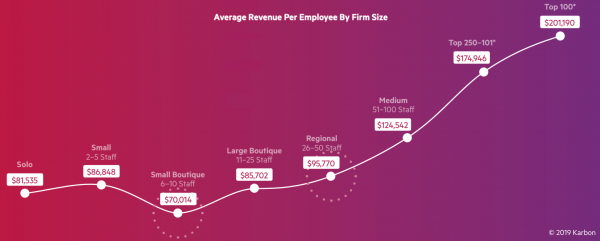The two bumps in the road you must anticipate and prepare for as you grow
There are two major bumps on the road as a business grows and the team expands. New challenges related to staff, management, resources and processes, only emerge once a certain size is reached.

This common growing pain is one of nine key insights identified in Karbon’s recent report, The Business Ability of Accounting Firms, which reveals the core weaknesses and progress of 250 firms across the globe that were assessed through our Practice Excellence Scorecard.
Karbon VP of Education, Ian Vacin, explains the learning in more detail in this video.
https://karbonhq.wistia.com/medias/srt0o23h83Revenue based on firm size
Charting firm revenue based on firm size presents a positive trend that is marred by two clear bumps in the road.

The first bump appears for small boutique firms—those with 6-10 staff. Firms who reach this size are trying to find their way, learn the best way to manage their team, and identify the right technologies and processes. They are also faced with hiring challenges, often for the first time.
Average revenue per employee for firms of this size is significantly less than smaller firms and sole practitioners because they are now hiring for resources that have more non-billable activities associated to them. The firm has to shift from having the luxury where all staff can do everything, to a situation where they need more specialized resources that aren't directly delivering services that are chargeable—such as a Business Development Manager, for example.
The second bump appears for firms classed as regional—those with 26-50 staff. While this bump isn’t nearly as severe, revenue growth does slow down. This is likely a result of the new challenges they are experiencing as their teams increase and become more hierarchical. This results in more inefficiencies and less capacity to serve a higher number of customers as each staff member was able to do prior.
The Karbon Magic Quadrant
The Karbon Magic Quadrant indexes accounting firms based on their Practice Excellence Score and their revenue per employee.
This diagram is broken into four quadrants based on values for the average firm:
Laggards: firms that aren’t investing in their teams or extracting above-average outputs from their staff.
Progressives: firms that have obtained business knowledge and have invested in their team, but are still achieving below average results. They have shifted their mindset but are yet to unlock the full benefits of their efforts.
High-performers: A lower than average firm in Practice Excellence ability that obtains higher than average revenue per employee. They have proven they know how to maximize each and every resource, but lack business expertise.
Leaders: A higher than average firm in Practice Excellence ability and revenue per employee.
Comparing a firm’s input and output based on staff numbers highlights further common growing pains. The overall trend line shows positive movement up and to the right, yet this movement in anything but a straight line.

Sole practitioners (1 staff member): With an average Practice Excellence score of 45% and revenue/employee of $81,535, sole practitioners are firmly in the Laggard quadrant. Working on their own, these accountants are clearly stuck in the weeds. They are wearing many hats and strongly focused on delivering for their clients and finding new clients. Therefore, they are unable to provide the time to learn, develop and grow.
Small (2-5 staff): Average Practice Excellence score of 52% and revenue/employee of $86,848. These firms have usually determined how to leverage a small team, technology, and ways of working together to be much more efficient for their size.
Small boutique (6-10 staff): Average Practice Excellence score of 52% and revenue/employee of $70,014. Growing to this size is when a firm needs to manage the fundamental dynamics of teams for the first time. An understanding of managing and delegating is required, with which many owners—who often started much smaller—can struggle with. They get bogged down, face a drop in efficiency and can struggle to let go of things they have always done themselves.
Large boutique (11-25 staff): Average Practice Excellence score of 55% and revenue/employee of $85,702. Firm owners who have the management and strategy proficiency can quickly grow their firm to this size. Good systems and processes are usually always in place within firms who have reached this size.
Regional (26-50 staff): Average Practice Excellence score of 49% and revenue/employee of $95,770. These firms usually have multiple-partners and are often based across multiple offices. This brings a whole new set of challenges and priorities brought on by size, and Practice Excellence takes a hit. Change is harder to implement and is slow. However, effectiveness per staff member increases, most likely due to being in a position to employ more junior staff at lower salaries. They can do more for less and drive more revenue.
Medium (51-100 staff): Average Practice Excellence score of 53% and revenue/employee of $124,542. Medium-sized firms have made it over the hump and rectified much of their growing pains. To reach this size they have found an ideal balance between Practice Excellence proficiency and employee effectiveness.